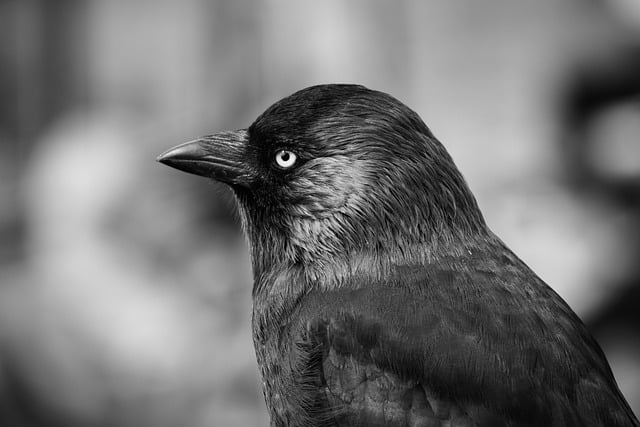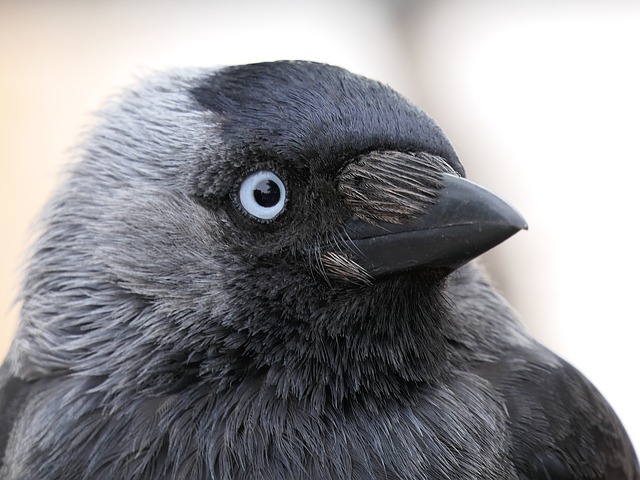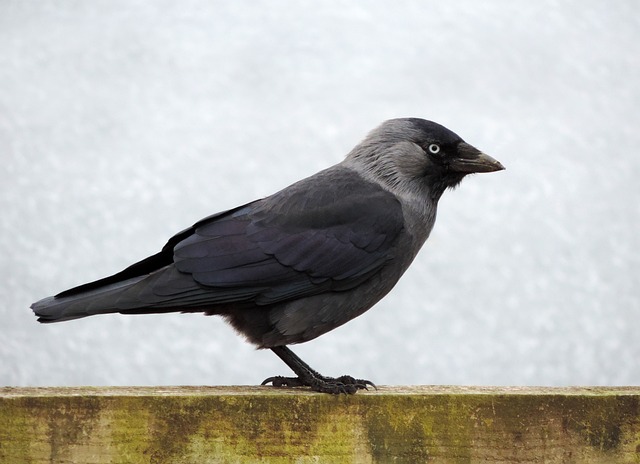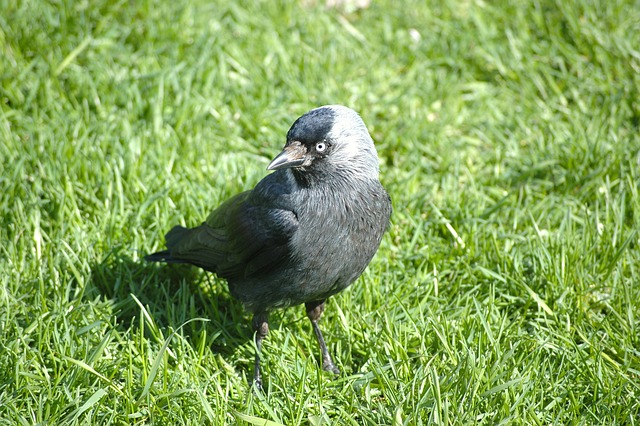The jackdaw is a fascinating species of bird that is found throughout the world. This guide will provide an overview of the jackdaw, as well as a detailed look at its physical characteristics, behavior, habitats, communication, reproduction, and interaction with humans.
Introduction
The most recognizable feature of jackdaws is their black feathers and distinct white eyes. They also have a unique call that can be heard from far away. Jackdaws are found in a variety of habitats, including woodlands, grasslands, and even urban areas. They have an omnivorous diet that consists of small insects, seeds, and grains.
Jackdaws are social birds and often live in flocks of up to 20 birds. They are known to be quite territorial and will defend their nests aggressively. They are also highly intelligent and have been known to use tools to obtain food.

Jackdaws have an extensive breeding season and nests are typically constructed in trees or on cliffs. Females lay between four and seven eggs and both parents take part in incubating them. The young are able to fly in about five weeks and they remain with their parents until the next breeding season.
Jackdaws have been part of human culture for centuries. They have been featured in folklore, literature, and artwork. They are also considered to be auspicious birds, often seen as an omen of good luck.
The purpose of this article is to provide readers with an in-depth look at the fascinating world of jackdaws. It will cover their physical characteristics, behavior, habitats, communication, reproduction, and interaction with humans. By the end of this article, readers will have a better understanding of jackdaws and how to interact with them.
Physical Characteristics
The jackdaw is a member of the crow family, Corvus monedula. It is a small, black bird that measures around 30-34 cm in length, with a wingspan of around 55-60 cm. It has distinctive grey feathers on its nape, which can be seen when it is in flight. Male and female jackdaws have similar appearances, but the male is slightly larger than the female.
The jackdaw has a black bill, black eyes, and black legs. Its feathers are glossy black over its head, back, wings and tail, while its underparts are a light gray. The wings are broad and pointed with white, barring on the coverts. Its tail is long and squared with a rounded tip. The beak of the jackdaw is short and pointed and is used mainly for gathering small food items and building nests.
The jackdaw is a highly social bird and is often seen in large flocks, as it prefers to be in the company of other jackdaws. The color of the jackdaws can vary, depending on the region and climate it inhabits. Jackdaws in Europe tend to be darker in color, while those in the United States and Canada are paler.

jackdaw
In addition to its distinctive grey feathers on its nape, the jackdaw also has white eyes, which can be seen when it is in flight. Its eyes are also larger than a typical crow's, and its legs are longer and thinner. The jackdaw's feathers are also more glossy than a crow's, giving it a sleek and shiny appearance.
Jackdaws can also be identified by their distinctive call, which is a sharp, high-pitched, nasal “kee-ar.” The calls can vary in frequency, volume, and length, depending on the purpose of the call. Jackdaws also have a wide range of vocalizations, including chattering, cawing, and whistling.
The jackdaw is an elegant and beautiful bird that has been admired for centuries. Its distinctive features make it one of the most easily recognizable members of the crow family. Its unique features and behaviors make it an interesting bird to study and observe.
Behavior
When it comes to behavior, jackdaws are quite fascinating creatures. They can be incredibly social animals, often forming large flocks and engaging in group activities. They are also very territorial, often fiercely defending their nest and roosting sites against other birds and animals.
Jackdaws are active birds and have a variety of behaviors that help them maximize their productivity. During the day, they spend time foraging for food around their territory and exploring new areas. They often scavenge for food in trashcans and on the ground, which can lead to them becoming nuisances in urban areas. At night, they roost together in large groups, often in trees or on rooftops.
Jackdaws are omnivorous and feed on a variety of foods. They mainly eat insects, such as beetles, caterpillars, and grasshoppers, but they also eat small vertebrates like mice and birds, as well as plant material like grains and fruits. They also have been known to feed on carrion, which can be an important source of nutrition in some areas.
Jackdaws are also known for their vocalizations. They have a variety of calls, including a harsh alarm call, a nasal chattering call, and a low-pitched cooing call. These calls serve multiple purposes, including defending their territory, communicating with each other, and warning of predators. In addition, they also have visual displays, such as head bobbing and tail flicking, which they use to communicate with each other.
Jackdaws are also known for their nesting behaviors. They build their nests in tree cavities, in crevices in rocks, and even in the roofs of buildings. They use a variety of materials to construct these nests, including twigs, grass, and feathers. The nests are lined with softer materials such as moss, feathers, and fur.
Jackdaws are also known for their parenting roles. Both parents will take part in feeding and caring for the young. The male bird will often bring food to the female while she’s incubating the eggs. The young are then fed by both parents and have a relatively long period of dependence. Eventually, they will leave the nest and begin to establish their own territories.
Habitats
Jackdaws inhabit a wide range of habitats, ranging from wooded areas to open fields, and from mountain ranges to cities. They are most commonly found in temperate and subtropical climates. They prefer to live in areas with plenty of open space, such as meadows, fields, and pastures, as this gives them a better view of potential predators and allows them to fly quickly away if necessary. They are also found in woodlands, though this is less common.
Jackdaws live in both large and small groups, depending on the availability of food. In large groups, they can be found in open areas, such as meadows, pastures, and fields. In these areas, they build colonies and nests in trees, shrubs, and other structures. In small groups, they typically choose to nest in cavities in buildings, trees, and cliff faces.
Jackdaws prefer to live in open areas, as these provide more space for them to fly and to hunt for food. These open areas also allow them to escape predators more easily. They also prefer areas with plenty of available food sources, such as grass, seeds, and insects.
Jackdaws are also attracted to areas with plains and hills, as these provide them with a perfect view of potential predators. They also prefer living in areas with plenty of trees, as trees provide them with plenty of places to build nests and roosts.
Jackdaws are known to inhabit a variety of habitats, even the harshest and most remote areas. They are also known to live in cities and towns, where they take advantage of the many food sources available and build nests in man-made structures.
Jackdaws are also known to inhabit coastal areas, where they take advantage of the abundant food sources available. They also enjoy living near rivers, lakes, and other bodies of water, as these provide them with plenty of opportunities to find food.
Overall, jackdaws prefer living in open areas with plenty of food sources and ample nesting sites. They are also known to inhabit a variety of habitats, even the harshest and most remote areas. They are also known to live in cities and towns, where they take advantage of the many food sources available and build nests in man-made structures.

jackdaw
Communication
Jackdaws have an elaborate communication system. They have a variety of vocalizations with nuances that enable them to communicate with one another. The primary purpose of their calls is to alert the rest of their flock to food sources, potential predators, and other dangers.
The most common call is a short, sharp “chack” sound, which is used to indicate danger and alert other jackdaws. They also have a longer, higher-pitched “chiming” sound, which is used to greet other jackdaws in the flock. Jackdaws also have “rhythmic chattering” calls they make when they’re excited or agitated. These calls are more complicated and contain a variety of different sounds.
In addition to vocalizations, jackdaws also use body language to communicate. They often raise their tails and spread their wings to show aggression. This behavior is often combined with vocalizations to indicate to other jackdaws that they are not welcome in the flock. Jackdaws also use body language to display submission and to express contentment. They may bow their heads and raise their wings in a sign of peace.
Jackdaws also use a variety of other vocalizations to communicate with each other. These include clicks, whistles, and purrs, which are used to communicate affection and to establish social bonds. They also use a variety of soft calls to communicate with their young, such as chatter, chirps, and murmurs.
Reproduction
The reproduction process of jackdaws is quite unique. The mating ritual usually takes place in the months between April and May. During this period, the male jackdaw performs a series of courtship rituals in order to impress the female. First, he spreads his wings, showing off his beautiful plumage, and then he begins to make a series of loud and unique vocalizations. In addition to vocalizations, the male jackdaw may also perform a “sky-dancing” display in which he dives and circles in the air.
Once the female has accepted the male’s courtship, they will then build a nest together. Jackdaws typically build their nests in trees or in buildings, and the female does most of the work. She uses grass, twigs, and feathers to construct the nest, and she lines it with moss to make it comfortable.
The female jackdaw usually lays four or five eggs per clutch. The eggs are incubated for around 18 days. During this time, both the male and the female will take turns to keep the eggs warm. After hatching, the chicks are fed a diet of regurgitated food by the parents.
Jackdaw chicks remain in the nest for around five weeks before they fledge, and during this period, both parents will take turns to feed and take care of them. The chicks will then stay with their parents for several months and learn important skills such as how to forage for food.
Once the chicks reach adulthood, they will eventually disperse and form their own breeding pairs. Jackdaws typically reach sexual maturity at around two years of age and can live for up to 18 years in the wild.
It is amazing to see the complex social behavior involved in the reproduction of jackdaws. From the male’s courtship ritual to the parent’s dedication during the chick’s early life, the jackdaw’s process of reproduction is a beautiful example of the complexity of nature.
Interaction With Humans
Jackdaws have been part of human culture for centuries. It is believed that the species’ intelligence and affinity for human activity have helped to make jackdaws a fixture in folklore and literature. In many parts of Europe, jackdaws are seen as a symbol of wisdom and power, while in other parts, they are seen as a nuisance.
The common jackdaw has been a part of human life since the dawn of agriculture. Archeological evidence suggests that jackdaws have been living in human-made structures since the Neolithic period. In more recent times, jackdaws have been depicted in literature and artwork in various countries, including the United Kingdom, Germany, and Italy. In these works, the jackdaw is often used to symbolize intelligence and cunning.
In much of Western Europe, jackdaws have a positive reputation among people. They are often seen as symbols of wisdom and are even sometimes referred to as the “wise old crow”. This perception is likely due to their ability to learn quickly and adapt to human activity. In some parts of Europe, jackdaws are even seen as a sign of good luck.
In other parts of the world, however, jackdaws are seen as pests. This is especially true in parts of North America, where jackdaws are seen as a nuisance due to their tendency to build nests in chimneys, eaves, and other areas of human dwellings. In some cases, they can even cause damage to property due to their nesting and roosting habits.
In many parts of Europe, jackdaws are viewed as a part of the culture. In some regions, jackdaws are celebrated in festivals and parades. In Germany, for example, there is an annual Jackdaw Festival that is held in the city of Freiburg. At this festival, people dress up in traditional jackdaw costumes, collect jackdaw eggs, and celebrate the species’ intelligence and beauty.
In addition to festivals, jackdaws have also been featured in artwork and literature. In the United Kingdom, the jackdaw is featured prominently in folklore and literature. For example, the jackdaw is the mascot of the University of Cambridge and is featured in the works of authors such as J.R.R Tolkien and Kenneth Grahame.

jackdaw
Conclusion
The jackdaw is a fascinating and unique bird that has captured the interest of people for centuries. This article explored the physical characteristics, behaviors, habitats, communication, reproduction, and interaction with humans of jackdaws.
To begin, we discussed the physical features of the jackdaw—notably the difference in coloration between males and females. We then explored the behavior of jackdaws, including how they nest and roost and what they feed on. We also discussed the geographical range of jackdaws and their preferred habitats.
We then discussed the vocalizations of jackdaws and explored the purpose of their calls. We also highlighted the nuances of jackdaw communication. We then delved into the mating process of jackdaws and the nesting behaviors they engage in. Finally, we discussed the history of jackdaws in human culture, the importance of jackdaws in folklore, and the general attitudes towards jackdaws.
In summary, the jackdaw is an extraordinary creature that exhibits some truly unique behaviors and features. Jackdaws are often found in temperate climates in open woodlands, grasslands, and on the edges of forests. They are highly intelligent and capable of adapting to different environments.
Jackdaws are also incredibly social creatures that communicate with one another through a wide array of vocalizations. They also exhibit a range of nesting and mating behaviors. Furthermore, jackdaws have a long history in human culture and are often associated with good luck and fortune.
When interacting with jackdaws, it is important to remain respectful and observant. While they may be curious and friendly, it is best to keep your distance and let them continue on their way.
Finally, this article highlighted the fascinating world of jackdaws, from their physical characteristics to their behavior and habitats to their communication and reproduction. We hope that readers learned something new about this amazing creature and feel inspired to observe them in their natural habitats.
